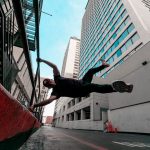Download links
How to install Mastering Parkour with taya773: The Ultimate Guide APK?
1. Tap the downloaded Mastering Parkour with taya773: The Ultimate Guide APK file.
2. Touch install.
3. Follow the steps on the screen.
Description
Parkour, often described as the art of movement, is a discipline that emphasizes fluidity, efficiency, and creativity in navigating obstacles. Originating in France in the late 20th century, parkour has evolved from a military training method into a global phenomenon that attracts practitioners of all ages and backgrounds. At its core, parkour involves running, jumping, climbing, and vaulting over various obstacles in an environment, whether urban or natural.
The essence of parkour lies in its adaptability; practitioners, known as traceurs (male) or traceuses (female), learn to interpret their surroundings and utilize their bodies to traverse them in the most effective manner possible. The philosophy behind parkour extends beyond mere physical movement. It embodies a mindset that encourages individuals to confront challenges head-on, both in the physical realm and in life.
This mental aspect is crucial, as it fosters resilience and determination. Parkour practitioners often speak of the importance of flow—maintaining a continuous motion that connects movements seamlessly. This flow is not just about speed; it’s about grace and control, allowing traceurs to navigate their environment with confidence and style.
Understanding these foundational principles is essential for anyone looking to delve into the world of parkour.
Key Takeaways
- Parkour is a physical discipline that involves moving through urban environments using only the human body and the surroundings to propel oneself.
- Strength and conditioning are essential for parkour, with a focus on developing upper body and core strength, as well as agility and flexibility.
- Mastering parkour techniques and movements involves practicing basic movements such as jumping, climbing, and vaulting, and progressing to more advanced techniques like precision jumps and wall runs.
- Overcoming fear and mental blocks is crucial in parkour, and can be achieved through gradual progression, visualization, and positive self-talk.
- Safety tips and injury prevention in parkour include proper warm-up and cool-down, using appropriate footwear, and knowing one’s limits to avoid overexertion and injury.
Developing Strength and Conditioning for Parkour
To excel in parkour, developing a solid foundation of strength and conditioning is paramount.
A well-rounded training regimen should incorporate exercises that target these areas specifically.
For instance, bodyweight exercises such as push-ups, pull-ups, squats, and lunges are fundamental for building the necessary strength to perform various parkour movements. These exercises not only enhance muscular strength but also improve functional fitness, which is crucial for executing dynamic movements like vaults and flips. In addition to strength training, conditioning plays a vital role in a traceur’s performance.
Cardiovascular fitness is essential for sustaining energy during longer sessions and for recovery between intense bursts of activity. Incorporating activities such as running, cycling, or swimming can significantly enhance overall endurance. Moreover, flexibility training through dynamic stretching or yoga can prevent injuries and improve range of motion, allowing for more fluid movements.
A comprehensive approach to strength and conditioning will not only prepare the body for the physical demands of parkour but also contribute to overall athleticism.
Mastering Parkour Techniques and Movements

Mastering the various techniques and movements in parkour is a gradual process that requires patience and practice. Fundamental skills such as landing, rolling, jumping, and vaulting form the backbone of parkour training. The precision of landing is critical; practitioners must learn to absorb impact effectively to minimize the risk of injury.
Techniques like the precision jump—where one leaps from one surface to another with accuracy—require not only strength but also keen spatial awareness and timing. Vaulting techniques are another cornerstone of parkour. The speed vault, for example, allows a traceur to clear obstacles quickly while maintaining momentum.
This technique involves using the hands to push off an obstacle while propelling the body forward with the legs. As practitioners become more comfortable with basic vaults, they can progress to more advanced variations such as the Kong vault or the lazy vault, each requiring different levels of skill and body control. Mastery of these movements is essential for building confidence and expanding one’s repertoire in parkour.
Overcoming Fear and Mental Blocks in Parkour
| Technique | Percentage of Improvement |
|---|---|
| Visualization | 80% |
| Breathing Exercises | 75% |
| Progressive Exposure | 90% |
| Positive Self-talk | 85% |
Fear is an inherent part of learning any new skill, especially one as physically demanding as parkour. Many practitioners encounter mental blocks that can hinder their progress. These fears often stem from concerns about injury or self-doubt regarding one’s abilities.
Overcoming these mental barriers requires a combination of mental fortitude and strategic training approaches. One effective method is visualization; by mentally rehearsing movements before attempting them physically, traceurs can build confidence and reduce anxiety. Gradual exposure to challenging movements can also help alleviate fear.
Practitioners should start with simpler variations of a movement before progressing to more complex ones. For instance, if a traceur is apprehensive about performing a backflip, they might begin by mastering backward rolls or practicing on a trampoline to gain comfort with the motion. Additionally, training with a supportive community can provide encouragement and motivation, making it easier to confront fears collectively.
Safety Tips and Injury Prevention in Parkour
Safety should always be a priority when practicing parkour. The dynamic nature of the discipline inherently carries risks; however, many injuries can be prevented with proper precautions and awareness. First and foremost, practitioners should always warm up adequately before training sessions to prepare their muscles and joints for the demands of movement.
Dynamic stretches and mobility exercises can enhance flexibility and reduce the likelihood of strains or sprains. Another critical aspect of safety is choosing appropriate training environments. Beginners should seek out safe locations with soft surfaces such as grass or padded mats when practicing new skills.
Urban environments can present hazards like uneven surfaces or sharp edges; thus, it’s essential to assess surroundings carefully before attempting any movements. Additionally, wearing appropriate footwear can provide better grip and support during training sessions. Practitioners should also listen to their bodies; if fatigue sets in or pain arises, it’s crucial to take breaks and allow for recovery to prevent overuse injuries.
Taking Parkour to the Next Level: Advanced Training and Challenges

Pushing Physical Limits and Fostering Creativity
Once foundational skills are established, many practitioners seek to elevate their parkour practice through advanced training techniques and challenges. This progression often involves setting personal goals that push physical limits while fostering creativity in movement. Advanced techniques may include flips, spins, or complex combinations of movements that require not only strength but also precise timing and coordination.
Competitions and Workshops: Opportunities for Growth
Participating in parkour competitions or workshops can also provide opportunities for growth. These events often feature challenges that test various skills under pressure, encouraging practitioners to perform at their best while learning from others in the community. Additionally, collaborating with experienced traceurs can offer insights into advanced techniques and strategies for overcoming obstacles creatively.
Contributing to the Evolution of Parkour
As practitioners continue to explore new challenges and refine their skills, they contribute to the ever-evolving landscape of parkour while deepening their connection to this dynamic discipline.
FAQs
What is parkour?
Parkour is a physical discipline that involves moving through an environment in a creative and efficient way, using only the human body and the surroundings to propel oneself.
Where did parkour originate?
Parkour originated in France, developed by David Belle and his group of friends in the late 1980s. It was inspired by military obstacle course training and various physical disciplines.
What are the basic movements in parkour?
Basic movements in parkour include running, jumping, climbing, vaulting, and balancing. These movements are used to navigate obstacles and terrain in a fluid and efficient manner.
Is parkour dangerous?
Parkour can be dangerous if not practiced with proper training and safety precautions. It is important to start with the basics and progress gradually to more advanced movements, and always train in a safe environment.
Can anyone do parkour?
Parkour is accessible to people of all ages and fitness levels, but it requires dedication, discipline, and proper training. It is important to start with the basics and progress at your own pace.
Are there any parkour competitions?
Yes, there are parkour competitions and events held around the world, where practitioners can showcase their skills and compete in various challenges and courses. These events often attract a community of parkour enthusiasts.





